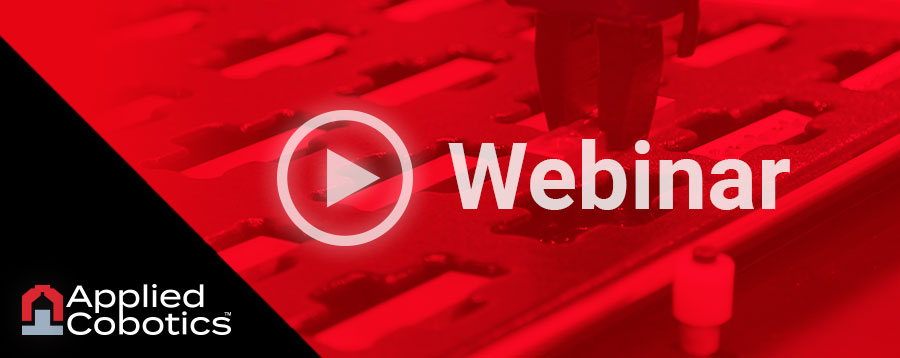
Recently, members of our Applied Cobotics team were guests on a webinar hosted by long-time moderator, Gary Jesh. The webinar, titled “Applied Cobotics Renews Manufacturing with Automation,” looks at how Illinois-based PBC Linear is meeting changing customer demands with automation tools to help revolutionize the manufacturing process. They are building flexible automation systems such as the Cobot Feeder, and incorporating collaborative robots and augmented reality machine-training programs into their factory of the future.
Sitting on the distinguished panel were Beau Wileman, product manager for Applied Cobotics and 3D Platform, along with Tim LeCrone, Director of Manufacturing Engineering at PBC Linear, and one of the newest team members, Derek Neises, Manufacturing Engineer and Robotics Specialist. Together they make up part of a core group of engineers, company leaders and frontline workers dedicated to strengthening American manufacturing.
Starting in 2020, we witnessed the pandemic turn the labor shortage into a real crisis for manufacturers of all kinds. The term “essential worker” became mainstream, and suddenly every factory in the Rockford-Chicagoland area needed more workers than were available. We quickly realized our reliance on direct labor was too high, and that we needed a sensible automation solution.
“When you have a machine sitting idle without an operator that's a really big problem, and that causes a lot of pain.” -- Tim Lecrone
We first set our sights on collaborative robots (cobots), which were perfect for all of our material handling processes. Twenty-five of them were purchased and deployed in that first year of the pandemic. We quickly learned that cobots were not the whole solution. The robot arms have a limited reach, restricting the amount of parts that can fit into the queu. Also, once the cobot runs out of parts it sits idle. That investment is not making any money and instead burdening workers to restock parts, which was counter-intuitive to our goal.
“What we really needed was a lights-out, unattended solution that would help us get the full value out of our cobots.” -- Beau Wileman
That led us to start developing our own solutions, one of which was to start 3D printing our own custom parts trays. Since 3D Platform is one of our sister companies, this was a seamless process. Once we had the trays and the cobots working in unison, we still had the problem of swapping out the trays.
“We have quite the range of parts that need machining (near 40,000 parts), so making flexible molds that can be quickly swapped in and out was essential to higher cobot productivity.” – Derek Neises
Out of this problem came our own unique solution, the Cobot Feeder. This flexible automation tool is essentially a cell that will load and unload up to 17 trays at once, cycling up and down, and moving those trays into perfect position in front of the cobots. This allows our upskilled automation engineers to load and go, servicing other areas of production and focusing on other duties like quality inspection.
“The Cobot Feeder is creating additional employee value. Employees that were once hand loading parts into the machine and then waiting while that machine was running are now essentially managers of a cell.” -- Beau Wileman
Now that we had a good solution for our automation, we still had that problem of training the workers. At PBC Linear, we began using virtual reality (VR) and Manifest software from Taqtile to create training programs. This technology allows us to capture valuable industry tribal knowledge from our more seasoned professionals, and also engage and entice a new younger workforce into manufacturing.
“In order for this transfer of knowledge to work we had we needed a platform that standardized everything, making sure that any shortcuts or bad habits weren't getting passed along, and every employee was learning the same knowledge, the same way.” -- Beau Wileman
All of this new technology on the factory floor is leading to the adoption of what we call the new collar worker. That is defined as someone that bypasses the typical 4-year college and instead trains through community colleges, vocational schools, software bootcamps, and technical certification programs.
Within the period from the start of the pandemic to the current date, PBC Linear was able to grow 33-percent in sales with only a 3-percent growth in head count.
“We were having record-breaking months with 20 percent of our workforce parked at home at any given time. The flexibility of the Cobots, tactile training, and Cobot Feeder along with these new collar workers have helped keep our factory running, and continue to break sales records!” -- Tim Lecrone